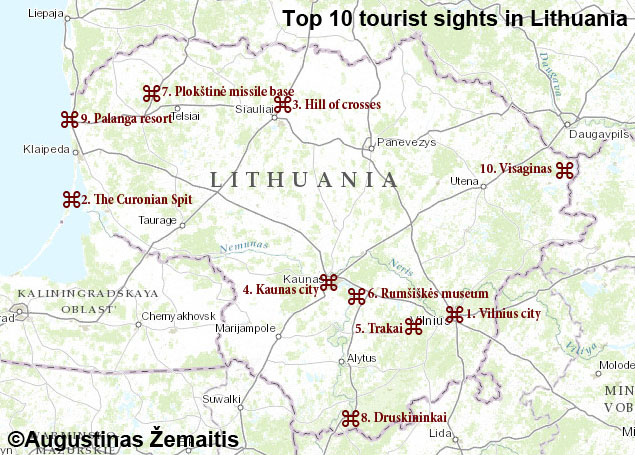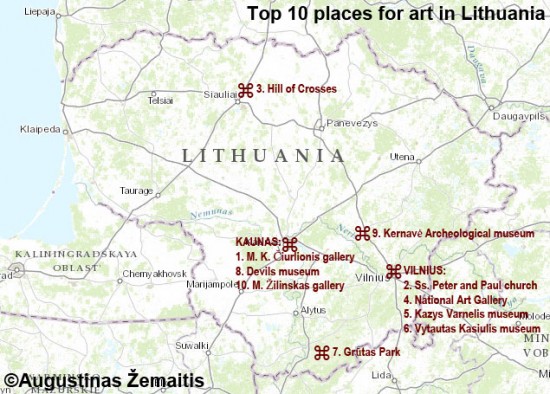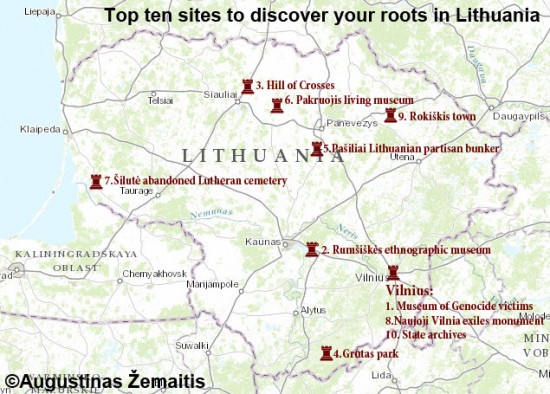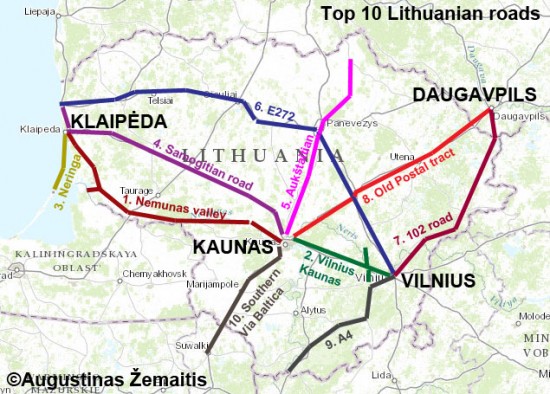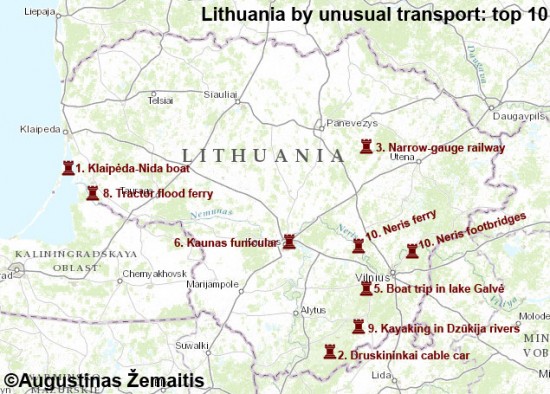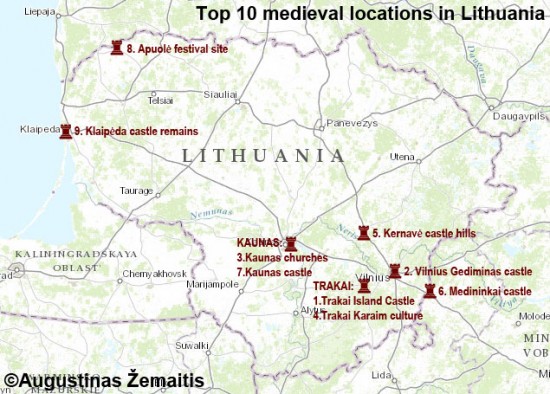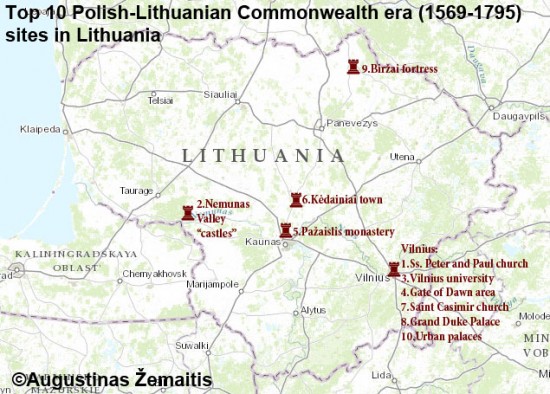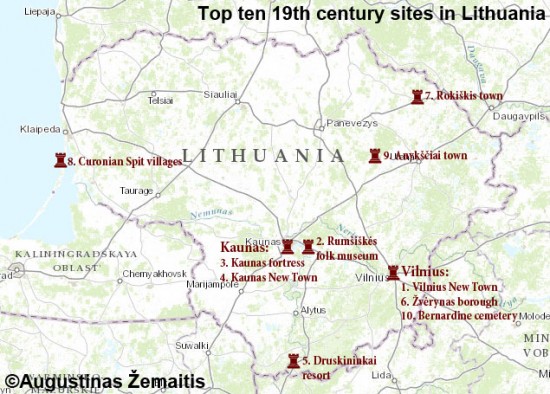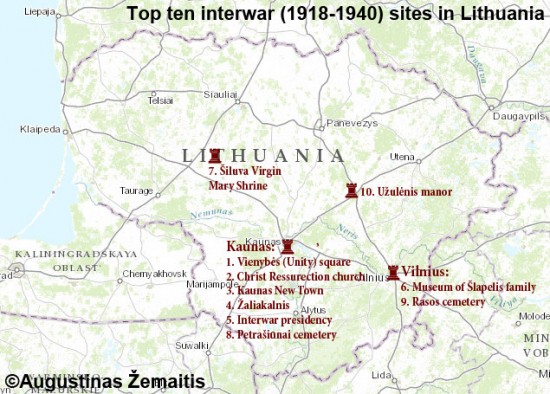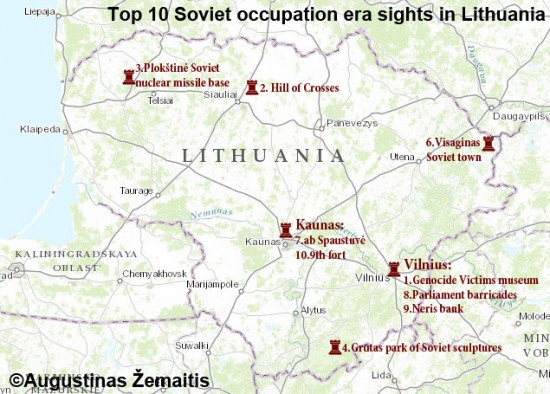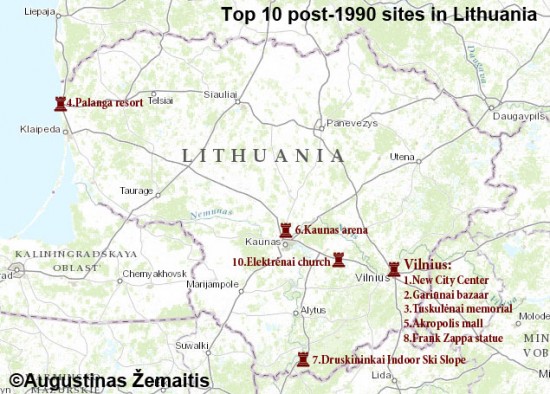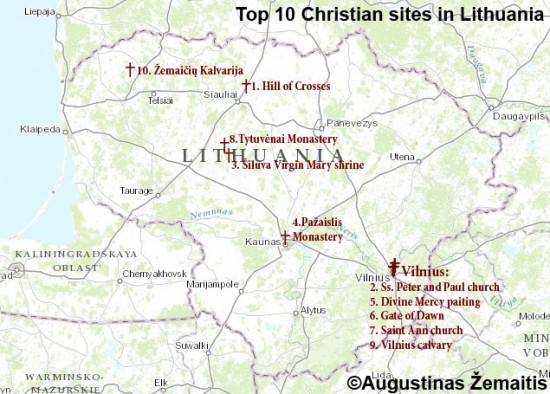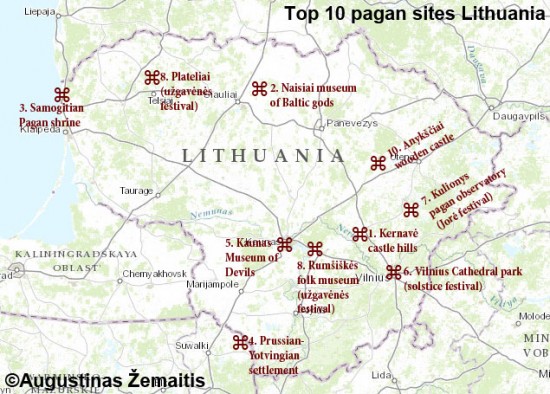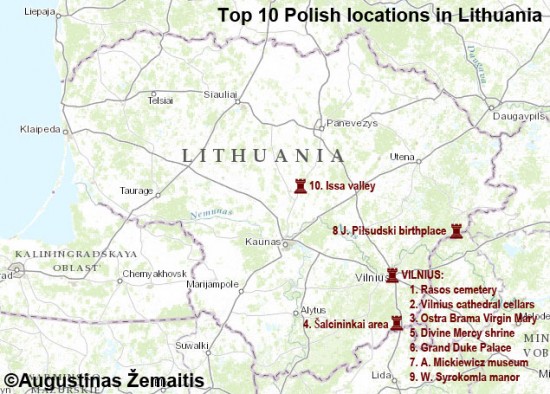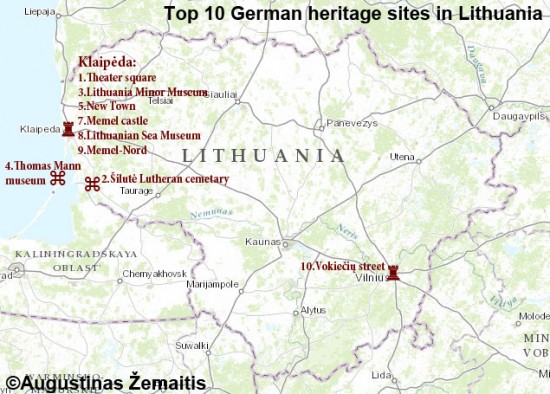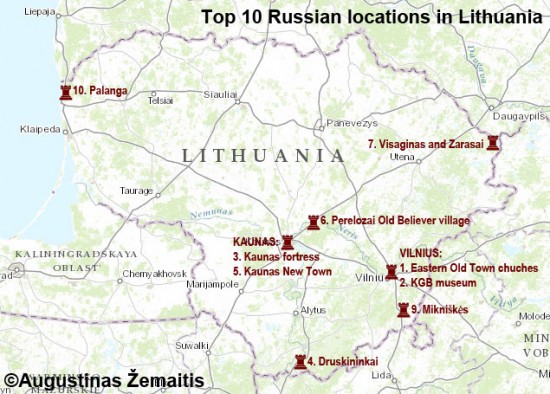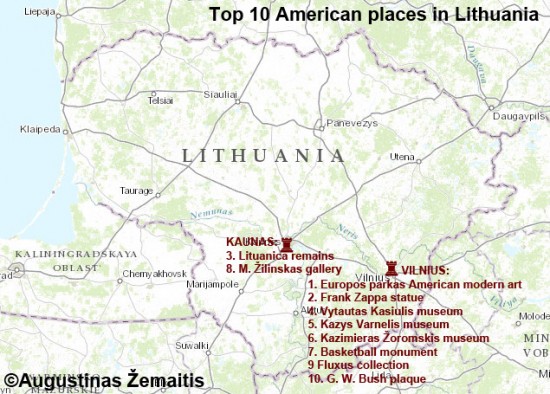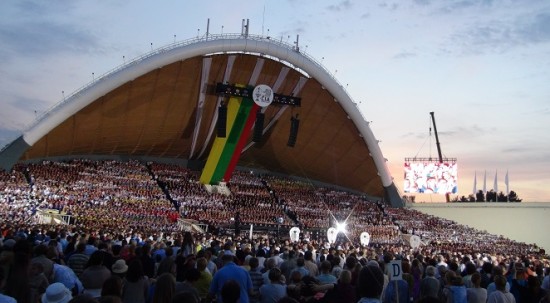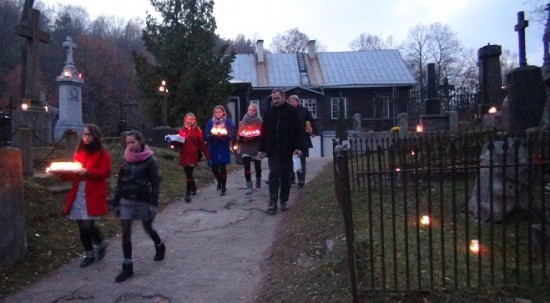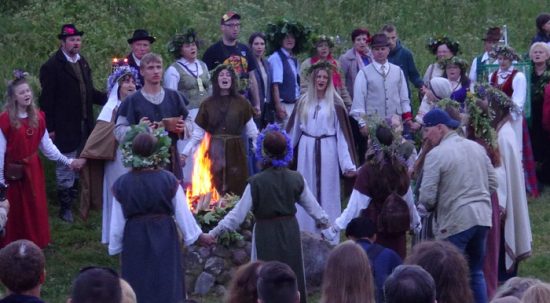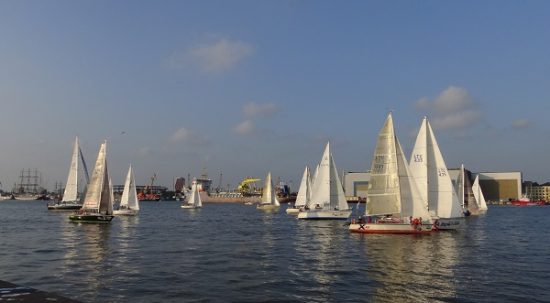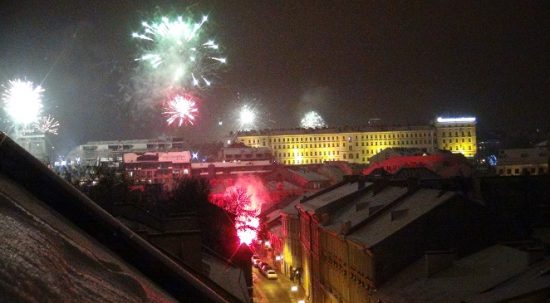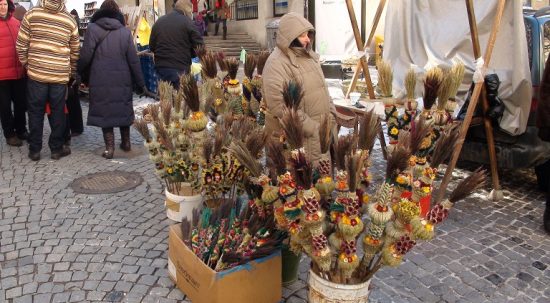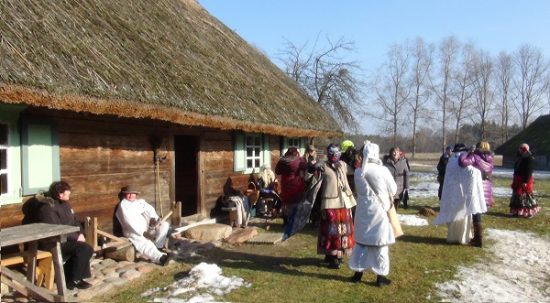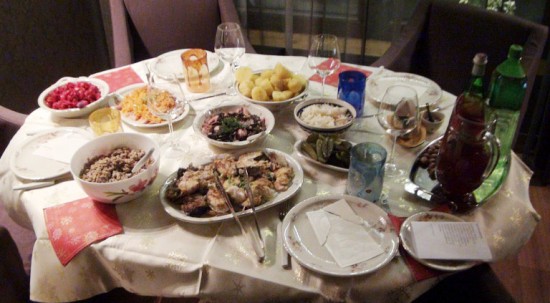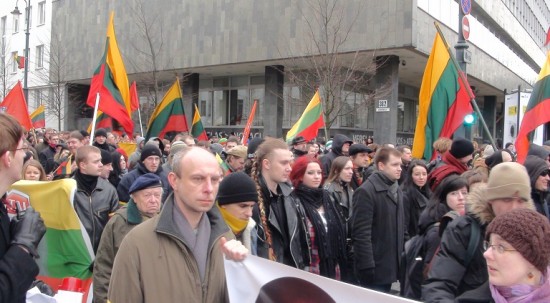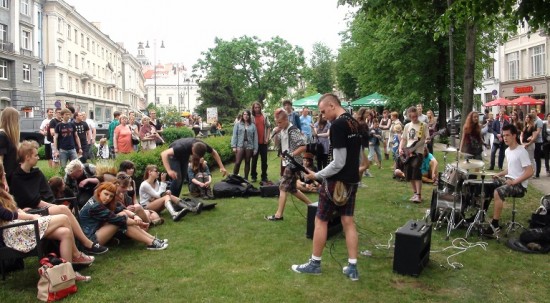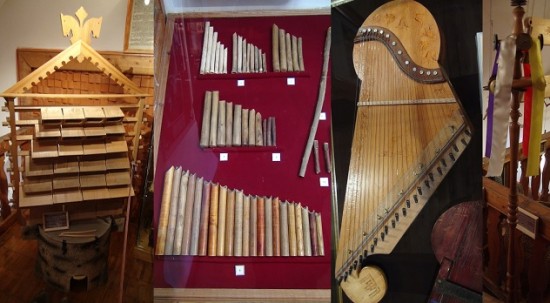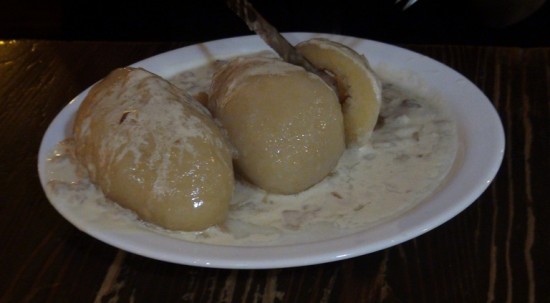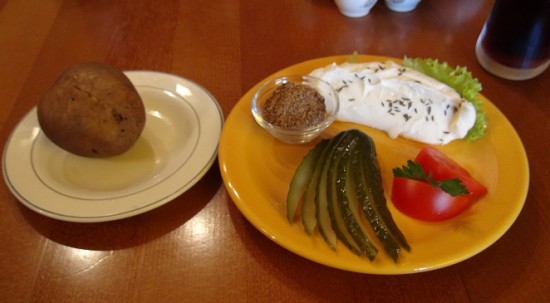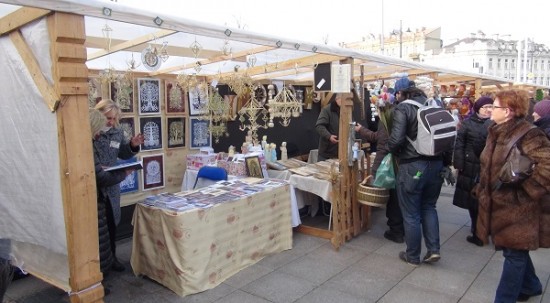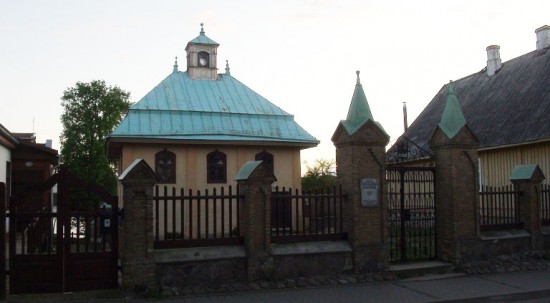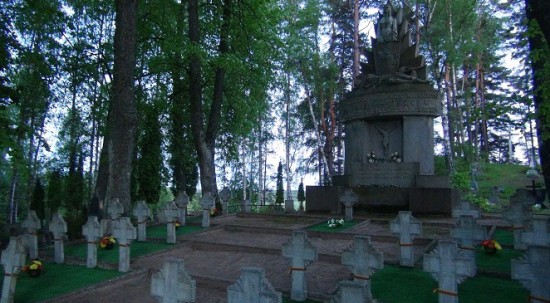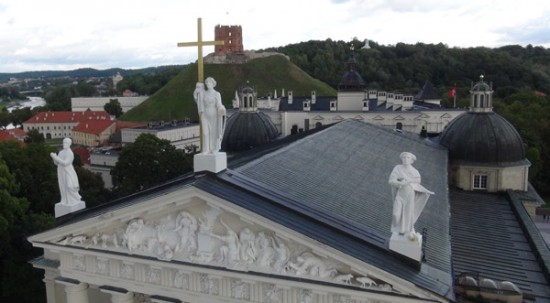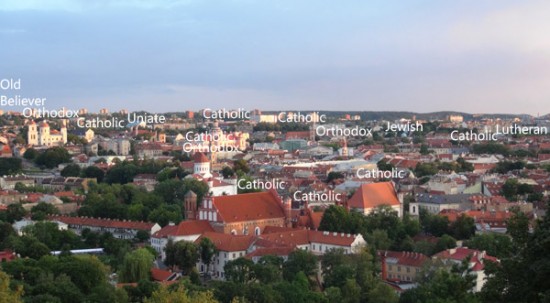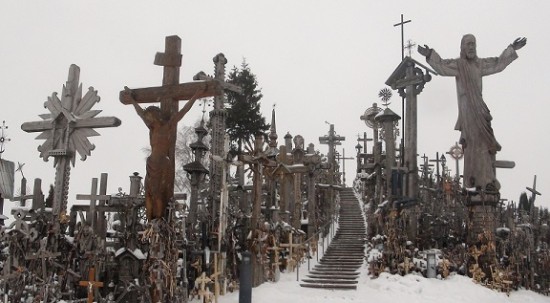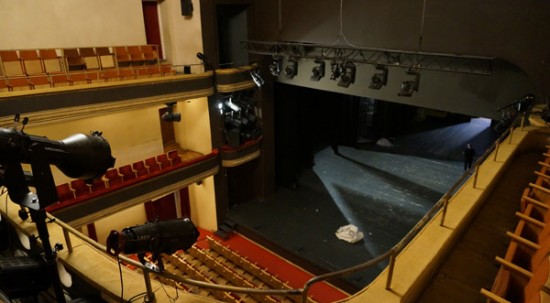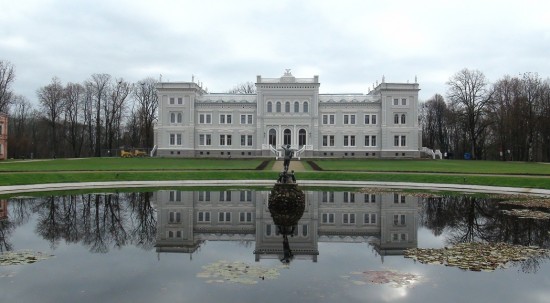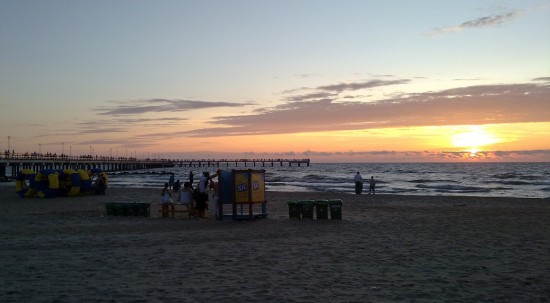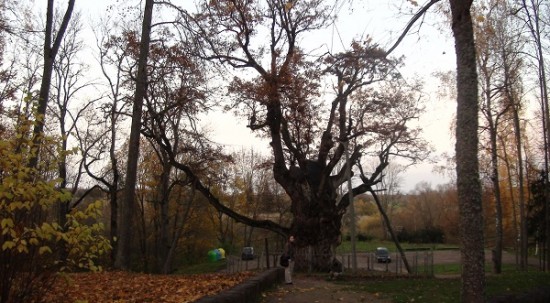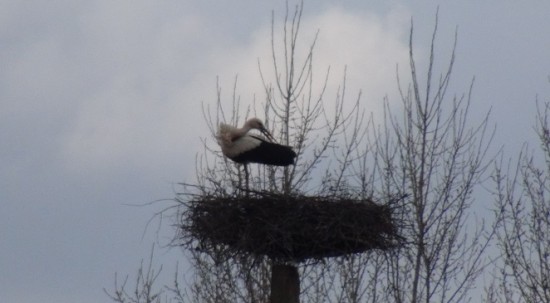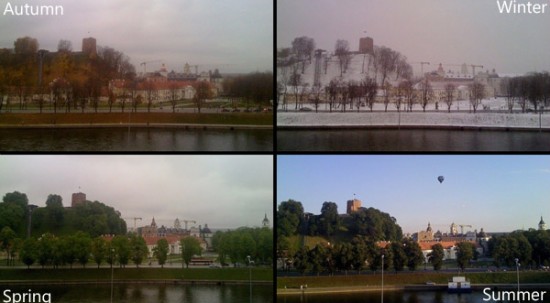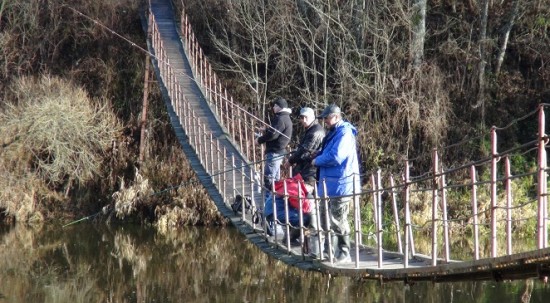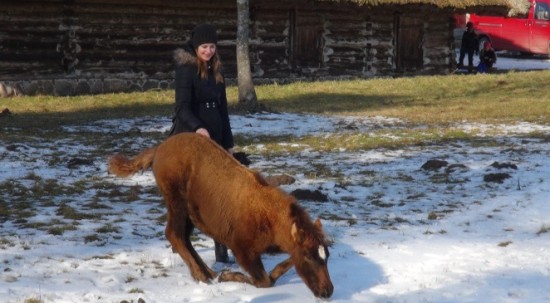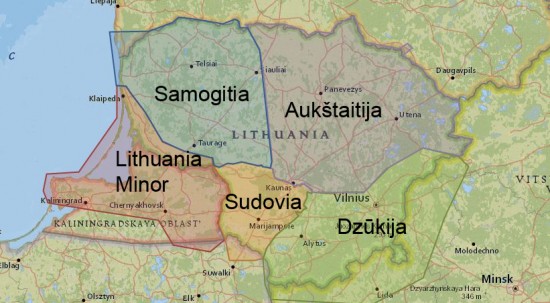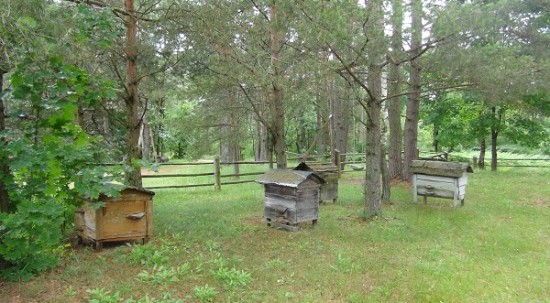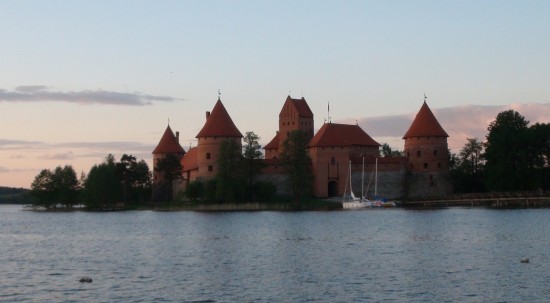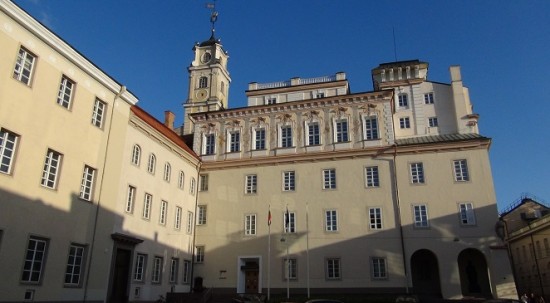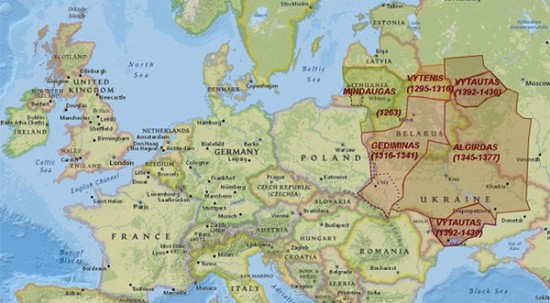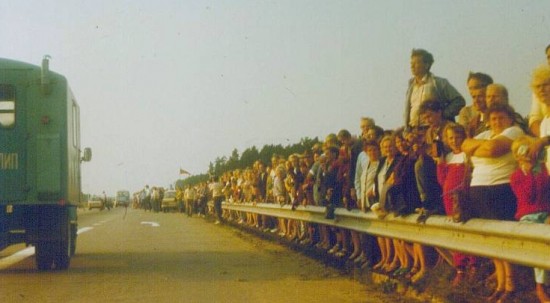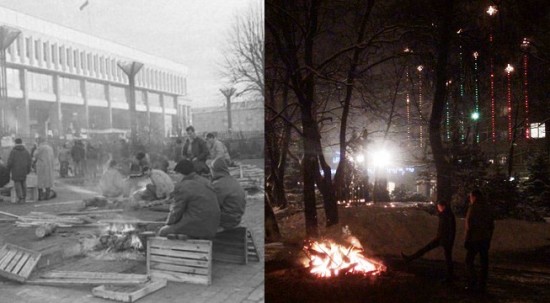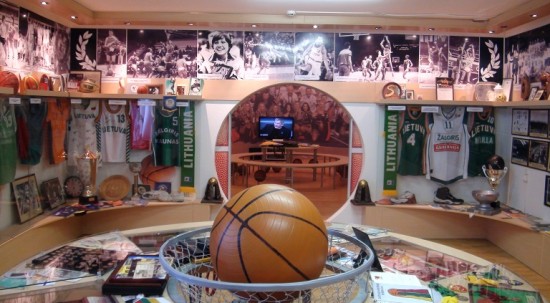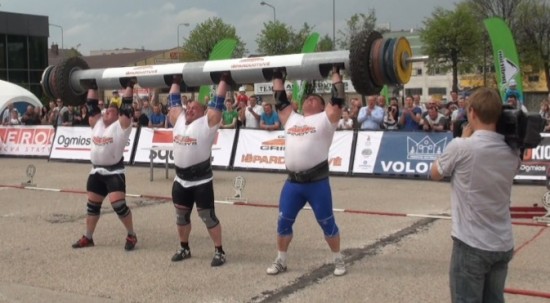All the selected icons are one or more of the following:
a)Unique to Lithuania.
b)Developed by Lithuanians.
c)Unusually prevalent or important in Lithuania.
If you have different suggestions or believe one of these icons should be replaced by another, you may suggest so in the comments.
Symbols of Lithuania
Vytis is the Lithuanian coat of arms. Dating back to the Grand Duchy of Lithuania it is among the Europe's oldest emblems. Atypically, its source is Grand duke's seal rather than a dynastic coat of arms. As Lithuania once stretched beyond its current boundaries some emblems in neighboring countries are also based on Vytis.
Lithuanian tricolor is a 20th-century creation. As the reestablished Lithuanian state (1918) was a republic a tricolor design was adopted. Since the French Revolution (1789) most European republics used similar flags.
Lithuanian anthem "Tautiška giesmė" (National Hymn) has been created in 1898 by Vincas Kudirka (adopted in 1920). It is notable for having each verse to follow a different melody and therefore should never be shortened (trimming the anthem in some sports events triggers discontent). A peculiar tradition calls every Lithuanian to sing the anthem on July 6th.
Columns of Gediminas and Cross of Vytis are two patriotic symbols repeatedly used wherever a touch of Lituanity is needed (architectural details, political party symbols, Lithuanian event emblems, national awards, etc.). By the way, Column of Gediminas is also used as the True Lithuania website favicon.
City/town coats of arms are the cherished symbols of every Lithuanian locality, used by local institutions. Originally reserved for cities that received an urban charter in the medieval era, now the emblems have been approved by State Heraldry Commission even for some villages. However, strict old heraldic rules on what could be depicted on emblems (and how) are upheld when designing new symbols.
Musical icons
Sutartinės. The Lithuanian multi-part folksongs where singers sing different lyrics creates a mysterious noise even to somebody who does not speak Lithuanian. They used to be sung at key annual events such as harvests, though now are mostly limited to folk music festivals.
Songs of the Singing Revolution inspired and led the Lithuania's transformation from a Soviet-occupied totalitarian society in 1985 to an independent libertarian nation of 1995. Risking persecution the singers did all that had been banned: experimented with Western styles, then wrote ever-more-daring lyrics on history and religion, later also business and sex. Many of the era's songs are still performed by the old and new singers alike.
Kanklės is a traditional Lithuanian string instrument held to be of special spiritual importance. Originally amateur it is now also used in folk orchestras.
Skrabalai is a Lithuanian folk percussion instrument: a large stand with wooden thoughs grouped in vertical lines, each having metal clappers in them to produce sound when struck.
Lithuanian folk dances usually have slower and faster parts and are danced in circles which transform into lines, "snakes" and other formations as the dance progresses, or may even temporarily "disintegrate" into pairs. The dancers' actions may be so elaborate that some Lithuanian dances are also known as "games".
Iconic meals and drinks
Cepelinai (a.k.a. Didžkukuliai) to most Lithuanians is *the* national meal, gauged by diaspora visitors and Lithuanian tourists returning from long voyages. There is even a World Cepelinai Day. These potato dumplings are named after dirigible they resemble.
Šaltibarščiai is the Lithuanian variant of borscht soup, served cold. Popular in summers it was also adopted in other neighboring countries.
Lithuanian beer. Beer is the traditional alcoholic beverage of Lithuania and the oldest surviving Lithuanian factories are invariably beer breweries and micro-breweries. Lithuanians widely see their beer as the world's best and over 90% of all beer consumed in Lithuania is Lithuanian.
Kibinas and Čeburekas. These two pasties of meat descend from the cuisine of two minuscule Turkic minorities (kibinas is Karaim, čeburekas is Tatar). However, they have effectively became the prime local variant of fast food, sold in kiosks, stands and even by salesmen who traverse beaches on foot.
Skilandis and Vėdarai are, respectively, stuffed pig's stomach and stuffed pig's intestines. Lithuanians love pork and most parts of it are considered edible.
Samogitian kastinys is a sauce made of smetana, sour milk, butter and spices where bread and potatoes are dipped at. The European Union designated it as a geographical reference making it illegal to use the name for non-Samogitian products.
Lithuanian mineral springs became famous in the 19th century. Mineral spring resorts (especially Druskininkai) are loved by Lithuanians and foreigners alike, while bottled mineral water "Vytautas" with its unique love-or-hate flavor is among Lithuania's best-known trademarks.
Rye bread (a.k.a. "black bread"), characterized by its stronger flavor and dark color, is such a Lithuanian staple food that many would not even question that it could unavailable somewhere. In many lands where Lithuanians emigrate to it isn't widely sold however and "bring me some black bread" is a request visiting relatives of Lithuanian expats would frequently hear.
Iconic holidays and festivals
Užgavėnės (46 days before Easter) is a carnival famous for its traditional hand-made papier-mache masks, representing various ethnicities, social classes, and animals. A pagan-inspired burning of the effigy of winter (Morė) and the triumph of vegetarian Kanapinis (Weed-man) over Lašininis (Fat-man) - marking the beginning of the Lent - are other peculiar traditions.
Kaziukas Fair (Little Casimir fair, the weekend before March 4th). Lithuania's oldest and largest fair fills the Vilnius downtown with traders (selling traditional candies, artwork, crafts and other things) and tons of visitors. Its beginnings likely lie in 1636 when the remains of Lithuania's patron saint Casimir were brought to be interred in Vilnius Cathedral.
Margučiai (Easter eggs) are folk art in Lithuania as they are elaborately painted using various traditional means. Then they are used for various games such as "who's egg is the strongest" or "who's egg will roll the furthest".
Joninės (June 23rd-24th) is the shortest midsummer night, characterized by bonfire burning and a pagan-inspired search for a blooming fern (now a euphemism for couples to spend some time together in a secluded location).
Sea Festival (A weekend in late July / Early August). Lithuania's favorite city festival is held in Klaipėda since 1934, attracting hundreds of thousands of Lithuanians from all over the country. Intended to promote Lithuania as a naval country it has concerts, parades, fireworks and other events located near the shore, as well as sea-related ceremonies.
Kūčios (December 24th) is the traditional Christmas Eve supper, more important to many Lithuanians than the Christmas itself. The whole family reunites for a vegetarian (fish permitted) treat of 12 meals where every participant tastes every meal. The supper is preceded by flatbread wafers which are shared as a prayer is said.
New Year fireworks are an everybody's issue in Lithuania. Throughout December Lithuanians shop at temporary kiosks for whatever makes sound and light. All these stockpiles are then fired around midnight December 31st/January 1st (a special law waives the need for permits). The sheer amount of colorful lights, explosion sounds and then smoke that covers entire Lithuanian urban skylines is spectacular.
Song Festivals are UNESCO-recognized quadrennial mass events where ~30 000 professional and amateur singers from all over Lithuania and diaspora communities come to Vilnius to sing Lithuanian songs together. The first Song Festival was held in 1924.
Iconic minorities and other groups
Poles of Lithuania are Lithuania's prime ethnic minority. Many of them are Lithuanians who adopted the Polish language over generations rather than migrants from Poland. For 16th-18th centuries Poles and Lithuanians were effectively a single nation, with the language to use depending on circumstances and social class. While later National Revivals and Soviet "divide and conquer" stratagem divorced the two nations, Polish-speakers still are the majority in the southeast, having their own dialect and much heritage there.
Jews of Lithuania (Litvaks) once had major communities in Lithuanian cities and towns as Russian Czar decreed Lithuania among the few lands under his control where he permitted Jews to settle. Mass emigration of the 20th century means that hundreds of thousands Litvak descendants now live in USA, South Africa, Israel and elsewhere.
Tatars and Karaims of Lithuania are a living reminder of the expansive Grand Duchy of Lithuania. Brought in by Grand Duke Vytautas in the 15th century from modern-day southern Ukraine these Turkic communities, while never surpassing several thousand in numbers, have safeguarded their culture, cuisine and religion, the Tatar wooden mosques and Karaim kenessas forming a curious addition to some Lithuanian cities and villages.
Lithuanian women. Regarded by many Lithuanian men to be among world's prettiest, the Lithuanian women have been also successful in the professional sphere. Lithuania surpasses every single Continental American and Western European country by female participation in the workforce (49,9%). Women also form the majority of Lithuanian researchers (51%) and have been firmly holding President and Speaker of Parliament jobs (in the past 10 years, both had women in them for a longer time than men). This situation evolved naturally rather than through quotas or discriminating males.
Lithuanian Americans, numbering up to 800 000, are the largest Lithuanian diaspora community. It has been especially important in garnering international support for Lithuanian causes. Every historic Yankee city has Lithuanian churches, cemeteries, and other heritage. Chicago, which ~1918 had more Lithuanians than any city in Lithuania itself, is the "capital" of Lithuanian Americans.
Lithuanian-Latvian brotherhood. Lithuanians and Latvians call each other "brother nations" and have always enjoyed especially cordial relations, never fighting a single war. Lithuanian and Latvian languages are the last two surviving Baltic languages and both nations shared much of their historical plights under foreign occupations.
Lietuvininks were the inhabitants of Lithuania Minor, the part of Lithuania that fell under a German (rather than Russian or Polish) rule. Having adopted Lutheranism and (partly) German language they nevertheless pioneered Lithuanian literature and philosophy. Nearly completely wiped out in the Soviet genocide, this part of Lithuanian nation left much heritage still enjoyed by Lithuanians and Germans alike.
Religious icons
Lithuanian paganism was the final pagan faith in Europe to retain state religion status. Lithuania converted to Christianity on 1385 but the pagan practices continued among peasantry for several additional centuries. They are still retained in the traditional holidays. Lithuanian paganism was relaunched in the 20th century and now became the Lithuania's fastest-growing faith, regarded by its followers to be the most Lithuanian one among religions.
Divine Mercy is a Lithuanian-originated Christian cult that is now celebrated by some 100 million Catholics and Anglicans worldwide. It all began as nun Faustina Kowalska received visions in Vilnius calling her to commission a painting of Divine Mercy. That miraculous original painting still hangs in Vilnius Divine Mercy shrine but many thousands of Christian churches on every continent now boast its copies.
Our Lady of Vilnius is a miraculous painting of babyless Virgin Mary of unknown origins that adorns the historic city gate (Gate of Dawn). For centuries it has been common for people to kneel on the street before it or make a sign of the cross when passing under. Multiple churches as far away as America have been named after Our Lady of Vilnius.
Our Lady of Šiluva was the first church-recognized Maryan vision in Europe (and second in the world after Our Lady of Guadalupe in Mexico) - this happened in 1608. Reverence of Our Lady of Šiluva gained patriotic flavors in the 19th and 20th centuries as various clubs organized Santiago de Compostella-style annual mass pilgrimage hikes to Šiluva. With Lithuania falling under or threatened by a foreign yoke throughout the era these were also a symbol of defiance as Šiluva became a national shrine (much the same as Our Lady of Guadalupe in Mexico).
Religious tolerance is especially deep-rooted in Lithuania. Some 11 religions have houses of worship that were built before World War 1. At the time Western Europeans burned their heretics on stakes (~17th century) it was common among Lithuanian Christian nobility to split their religious donations among several denominations. Since medieval times Lithuania both respected the practice of minority faiths (Islam, Karaism, Judaism) and offered refuge for persecuted religious minorities from abroad (Russian Old Believer sect in the 18th century).
Verbos of Vilnius are colorful contraptions of dried leafs and flowers that traditionally replace palm leafs on Palm Sunday at Vilnius area churches.
Saint Casimir is a patron saint of Lithuania and also the only saint of Lithuanian origin. He was a pious Lithuanian prince whose reverence started soon after his death and to this date, many Lithuanian churches both in Lithuania and abroad are dedicated to St. Casimir.
Lifestyle icons
Private home is especially important in Lithuanian culture where 92% own their homes with no credits attached. Many homes are even self-designed with renting considered acceptable only for students and expatriates. On the other hand, the cherished home ends at its front door/gate and communal property beyond that may be somewhat neglected. Even when changing homes Lithuanians tend to stay attached to their town or district.
Saving is the most respected way to raise money in Lithuania. Living on credit is frowned upon and equated to addiction. An older car paid "up front" may be preferable to a leased new one, and even many poor Lithuanians have considerable savings "for that black day".
Lithuanian roads are among the best in Eastern Europe, making cars extremely popular and seen as a necessity. Public transport is used mostly by the poor and those unable to drive, and even there, buses have outcompeted trains, ships, and planes for domestic voyages.
Pessimism has been an important feature of Lithuanian culture through the ages. For example, "Valley of tears" is used as a euphemism for "The world", happyends are rare in films/literature, while both funerals and weddings were historically seen as worth weeping for (as one state of life changes to another). In most situations pessimism about future still predominates and Lithuania leads the world in suicide rates (or "exit" rates, as another popular euphemism goes).
Bazaars may seem hectic and uncomfortable as the shoppers are exposed to the weather. However many Lithuanians prefer to buy there. Many salesmen are part-time and the bazaars get liveliest in early weekend mornings. While the income from such irregular business may seem meager it was these bazaars where Lithuanian capitalism was reborn in the 1990s; many Lithuanian millionaires have bazaar salesmen experience.
Shopping malls are the new leisure hubs of Lithuanian cities since ~2000 as Lithuanian businessman pioneered their development in Eastern Europe. Nowhere you will find as many people spending weekends as in the city's prime mall, where the best cinemas, ice rinks, bowling alleys, casinos are available. Furthermore, many malls are centrally located. Lithuanian shopping malls also attract shoppers from foreign Eastern European countries that still lack their own quality shopping opportunities.
Vilnius-Kaunas rivalry. Unlike most Eastern European countries Lithuania lacks a primate city, leading to a dispute between the top two. Vilnius is older, more populous and was the capital in medieval times. Kaunas has more ethnic Lithuanians, is centrally located and served as a capital in the interwar era. While the rivalry is the most prominent in sports, any discussion on the quality of urban life may disintegrate into a Vilnius vs. Kaunas thing.
Art icons
Cross-crafting is an elaborate Lithuanian folk art, a UNESCO world heritage. Wooden crosses and chapel-posts crafted by dievdirbiai ("godmakers") line up Lithuanian roadsides. They may also be found in large numbers in šventvietės ("holysites"). Hill of Crosses with its millions of wooden crosses is by far the most famous one. Rūpintojėlis, a Lithuanian sculpture of a sad Jesus Christ, is a popular addition to the crosses.
Sodas is a hanging geometric contraption made of straw. Traditionally used during holidays and weddings sodai now became a symbol of local identity in Lithuania and neighboring countries. Straw is also still popularly used to make bags.
Mikalojus Konstantinas Čiurlionis (1875-1911) is the best known Lithuanian artist. He created a unique form of art synthesis as his otherworldly symbolist paintings are joined by the music he composed. A mountain range and an asteroid have been named after him.
Lithuanian theater performances are famous for their symbolism, developed under the Soviet occupation when ephemeral theater may have been the best-suited art for hidden anti-government meanings ("Aesopic speech"). Now participating in many festivals and foreign collaborations some Lithuanian troupes sell off their local performances for months in advance.
Fluxus movement of protest art was started by Lithuanian Americans Jurgis (George) Mačiūnas and Jonas Mekas in the 1960s, denouncing the market demand and traditions in the name of coincidences and new forms of art synthesis. Largely unknown in the Soviet-occupied Lithuania Fluxus was discovered after 1990 independence and became a symbol of the modern Lithuanian art.
Architectural icons
Piliakalniai are iconic small-but-prominent hills that once hosted Bronze Age wooden castles of the Baltic tribes. Some 840 of them are strewn all over the country (1 per 80 sq. km). Since 19th century they are venerated as a missing link to the mysterious prehistory, becoming a popular hiking destination for panoramas of the vast surrounding lowlands (Lithuania is the world's largest country without a location above 300 m). One group of piliakalniai (at Kernavė) has even been enshrined as UNESCO world heritage.
Lithuanian vernacular architecture is famous for the elaborately carved details that adorn wooden manors and churches. Peasants' wooden homes are more simple but still had some intricate roof details (čiukuras, lėkis). Deprecated throughout the 20th century the traditional wooden homes now gained popularity as summerhouses. Interestingly, later urban planning left many 19th century wooden suburbs intact.
Baroque churches of Vilnius are some of Lithuania's greatest architectural wonders. ~15 Baroque churches survive in Vilnius and there is even a substyle known as Vilnius Baroque. Characterized by tall slim twin towers it has been emulated in 18th-century churches all over modern-day Lithuania, Poland, and Belarus. In the 20th century, Baroque was held to be "the most Lithuanian historic style" due to its prevalence in Vilnius and architects aimed to give their creations a small taste of Baroque.
Nobility manors still dot the Lithuanian towns and countryside. Each served as a hub for its town or region, as the nobles had been more powerful in Lithuania than anywhere else: not only did they own towns and peasants, in a system known as a "Noble democracy" they could have also voted to give orders to the King himself. Most cultural, technological achievements and political intrigues took place within manor palace walls until the 20th century. While many manors are now derelict, some were restored to former glory.
Monasteries, even if faded and stripped of their riches by the occupational regimes, still impress with their oldest-in-town buildings. Once invited to help make and keep Lithuania Catholic the monastic orders became a part of Lithuanian social fabric for centuries. Monasteries were desired places for non-heir nobility men and among the few ways for commoner women to gain political influence.
Revivalist town churches are so massive that they seem to be teleported from a much bigger city. The church construction boom came ~1904 when Russian Empire eased up anti-Catholic discrimination. Peasant communities celebrated this by erecting grand naves and towers with artistic decorations imitating those of medieval and Renaissance masters. A century later these churches remain the main dominant feature of Lithuanian countryside.
Smetonic architecture prevailed in the prosperous interwar period under President Smetona's rule. Combining art deco ideas with curved lines, ethnic patterns and patriotic symbols it sought to create a new style for a newly urban Lithuania. Especially prevalent in the "temporary capital" Kaunas, the search for "modern national style" continued in diaspora even after Lithuania was occupied.
Natural icons
Seaside sand dunes, ranging from the spectacular "Lithuanian Sahara" to modest, hug the entire Lithuanian seashore. They act as a windshield allowing comfortable sunbathing at an otherwise cool weather. Except for the hottest weeks, Lithuanian vacationers usually alternate their beach time between the cool (e.g. +16 C) sea and the sun-baked privacy at the dunes. For even less prying eyes there are dunes at gender-segregated naturist beaches, another old Lithuanian tradition.
Nemunas is the "father of Lithuanian rivers" that also gives the country many famous locations: so-called "loops", Kaunas Reservoir, castle-clad Nemunas valley and then the floodplains of Nemunas delta which are submerged every spring, turning the local farmsteads into island homes where boats replace cars as the prime vehicle. Nemunas basin covers 72% of Lithuanian territory.
Baltic Sea sunset is a traditional must-see for the romantic visitors of Lithuanian seaside. It is impossible to see the sun setting anywhere else but into the Baltic Sea when standing on Lithuanian coast - as the straight island-free shoreline entirely faces the West.
Oak is the national tree of Lithuania. It symbolizes strength and masculinity in the folklore and is considered the king of trees, even though only 2% of Lithuanian forests are oak forests.
Rue is the national flower of Lithuania. Laurel of rues used to be commonly added to bridal clothes to symbolize virginity.
Amber. Lithuania is one of the few countries in the world where amber may be found on shores. Originally used for jewelry it now has many other uses and as an expression of Lituanity. It has been a popular souvenir for over 2000 years as even the Roman Empire used to import amber from the Baltic tribes through what was known as the "Amber road".
White storks are the national birds of Lithuania. Flying gracefully and hunting frogs in the fields they are also a part of folklore. Lithuanians even make them nests as traditionally they are regarded as guards for the farmstead where they breed. A typical toddler's question "Where I came from [to this world]?" is traditionally answered "A stork brought you here" by parents.
Forest foraging is a popular Lithuanian pastime, unrestricted even on private property and national parks. In summer/autumn, even city dwellers flock into far-away forests in search of wild berries and mushrooms which they then consume or sell. Hobby value now outweighs any economical gain for most, but it still requires the same generation-to-generation wisdom on how to distinguish the edible from inedible that helped prehistoric Lithuanians to survive.
Four seasons in Lithuania are extremely different. Temperatures may surpass +35 C during the "green" summers and may fall under -30 C in "white" winters. The annual cycle of works is still important in villages but even in urban environment mandatory car tire changes, tremendous heating bills, and icicle hazards do not let to forget about the seasonal change.
Fishing is a favorite hobby of Lithuanian men. They rise up early and stock up at 24/7 fishing stores in order to take a position at the best lakes. This is year-round as some favor fishing in frozen lakes through a drilled hole. A good catch is invariably eaten. The seaside fishermen villages are now a popular tourist destination (especially during "fish festival weekends").
Žemaitukas is a Lithuanian breed of horses dating at least to the Medieval era when they carried Lithuanian armies to wars against Crusaders and Mongols alike. Nearly as small as ponies they are famous for their endurance. Žemaitukai start the annual Sartai ice carriage race.
Cultural icons
Agriculture is in the Lithuanian essence as three generations ago Lithuanians were virtually an all-peasant nation. Many urban dwellers still visit "their village" to give a hand in harvests or own a piece of suburban agricultural land for hobby farming. While large businesses have entered agriculture there are still "traditional peasants" who own small lands and herds of animals for subsistence.
Beekeeping, while still popular, is believed to even had more sacral meanings once. This may be evident in the language where the same word for dying is used for bees and humans (and not any other animals). Moreover Lithuanian word for "good friend" is "bičiulis", deriving from "bitė" ("bee") as only the best friends once would have gifted bees to each other. Traditionally bees were kept in tree cavities.
5 ethnographic regions are the main sub-ethnic divisions of Lithuania. Most of them have never formed official administrative units but every Lithuanian knows his region and each region has dialects, stereotypes, traditions, physical features and dishes associated with them. Stubborn Samogitia, frugal Sudovia, forested Dzūkija, lake-filled Aukštaitija and the German-styled Lithuania Minor - only together they form Lithuania.
Pirtis (Baltic bathhouse) is a hot hut where people sit before plunging into the cool water. Steam there is generated by pouring water over heated stones. The bathing ritual in pirtis includes beating each other with a vanta (~tree branch). An integral part of every farmstead complex, pirtis also served other purposes such as giving births. Today they are a form of entertainment/socializing that attracts urban Lithuanians to the countryside. This form of a bathhouse is Baltic in origin and calling it a "Russian bath" is a misnomer.
Respecting the dead is especially important in Lithuanian culture. For some 3 days acquaintances may contemplate and lament near a dead body and relatives kiss it during the "final goodbye". An initial wooden grave cross is invariably replaced by a massive tombstone. Next to it, a grass patch or even a well-cared-for flower garden may be created. Visiting relatives' graves is popular throughout the year but it is nearly universal during the Vėlinės festival (November 1st) when cemeteries are transformed into seas of candles.
Lithuanian folk costume consists of a colorful jacket (patterns dependant on region) and a white shirt underneath. Men wear trousers; women wear shirts and also cover their head with a scarf. Traditionally worn by all peasants the costume is now largely limited to folksong choirs and some patriotic events, but they are still well-recognizable.
Ethnic patterns are traditional geometric symbols coming from woven textiles. Originally used for clothing they became so symbolic that separate "ethnic strips" are crafted consisting of just an ethnic pattern. There is no definitive list of ethnic patterns but Lithuanians can usually feel which pattern is Lithuanian and which is not.
Lithuanian aviation. Lithuania is among the world leaders in hot air balloon numbers per capita and aerobatics is well-loved. The first Lithuanian pilots to cross the Atlantic ocean (Darius and Girėnas) are now in the national pantheon next to top monarchs, artists, and scientists. Commercial flight crews are also treated honorably - customarily, they are applauded during landing.
Lietuvybė (Lituanity, Lithuanianness) concept covers a wide variety of cultural traits, traditions, thoughts, and activities held to be Lithuanian (much of them on this list). Lithuanians may disagree about what exactly is part of Lietuvybė and what is not, but the wish to protect Lietuvybė in both Lithuania and diaspora is widespread. After all, only in a nation with a large patriotic diaspora could such a concept have developed.
Iconic locations
Trakai Island Castle is the only water castle in Eastern Europe. Romantically renovated it is among the prime symbols of Lithuania. Joined by Peninsula Castle, wooden old town and a medieval church Trakai town is the favorite day trip from Vilnius, enjoyed by simple tourists and foreign heads-of-state alike.
Vilnius University is among the Eastern Europe's oldest institutions of higher learning. Its students and professors make an integral part of Vilnius city since 1579 and its Renaissance central campus crowned by Ss. Johns church is among the prettiest buildings in Lithuania.
Vilnius Old Town. Once the heart of massive Grand Duchy of Lithuania, Vilnius Old Town surely has a fair share of opulent churches and palaces lining its labyrinthine streets and yards. It is also the Lithuanian site that attracts the most tourists.
Palanga resort is nicknamed "the summer capital of Lithuania" as this town of 16 000 easily becomes the nation's most populous city during the hottest weekends. It has been changing together with Lithuania (old parks and villas now joined by loud gigs) - but modern singers dedicate their romantic songs to what is *the* Lithuanian seaside resort just as their 1920s counterparts once did.
Curonian Spit is the best known Lithuanian natural wonder. This 98 km long narrow peninsula hosts massive sand dunes, distinct fishermen culture and pristine nature for an ecological holiday.
Lingusitic and literature icons
Lithuanian language is held to be the living language closest to Sanskrit. It is spoken in Lithuania for over 4000 years, putting it among the European languages continuously spoken in their area the longest time. Once neglected as a "peasant tongue" and suffering assimilation for centuries it made a spectacular comeback during the 19th century National Revival and became spoken by all the social classes once again. Native-level fluency in Lithuanian is now among the key distinctions on who is a Lithuanian and who is not.
Lithuanian name endings. Lithuanian female surnames are unique in the world for having different versions based on marital status: they end in "-aitė", "-ytė", "-ūtė" or "-utė" for unmarried women and "-ienė" for married. Male surnames differ from both, ending in either "-as", "-us", "-a" or "-is". Sadly, part of these centuries-old traditions has been removed as per a directive of European Union (and thus became rarer in younger couples).
Lithuanian mythology has many unique gods and creatures. Even the characters common in foreign mythologies, such as a devil, are depicted extremely differently. They are rarely purely good or evil and thus unpredictable. Famous creatures are Aitvaras, Ragana (witch), Laumė, Maumas, Baubas, Kaukas, Žaltys (serpent), Velnias (devil).
Maironis (1862-1932) is known as the Lithuania's greatest poet. His patriotic poetry (also adapted into many songs) inspired the 19th century National Revival and Lithuanian generations ever since, especially under tribulations and occupations.
Lithuanian exodus literature are novels and poems written by refugee intellectuals who fled the advancing Soviet armies in 1944. They integrate worldwide trends with an over-arching theme of longing for the lost homeland. Originally published by the diaspora and for the diaspora, it used to be banned in Soviet-occupied Lithuania before 1990 independence.
Historical icons
Grand Duchy of Lithuania was the Europe's largest medieval state, stretching from Baltic Sea to the Black Sea under the reign of Grand Duke Vytautas the Great (1392-1430). It covered most of modern-day Lithuania, Belarus, and Ukraine as well as parts of Poland, Russia, Latvia, and Moldova. Hundreds of Lithuanian-built castles, palaces and monasteries still remain in these lands. Many of them are among the prime tourist sights and some are UNESCO heritage. Medieval festivals give a glimpse of that era.
Žalgiris Battle (a.k.a. Grunewald, Tannenberg, 1410) is held to be the greatest medieval Lithuanian military victory and one of the largest medieval European battles (up to 50 000 dead soldiers). The united Polish-Lithuanian force defeated crusading Teutonic Knights, effectively ending 250 years of Lithuanian-Teutonic rivalry. Lithuania's top sports franchises are now named after Žalgiris.
Knygnešiai ("Bookcarriers") were smugglers who illegally imported Lithuanian books into Russian-occupied Lithuania after the Russian Czar had banned Lithuanian language (1864-1904 period). Their UNESCO-recognized unique feat allowed the Lithuanian language to survive the russification campaign and Lithuanian national revival gained full swing, also supported by the underground Lithuanian teachers (daraktoriai).
Soviet (Stalinist) Genocide (the largest 20th-century genocide) has also ravaged Lithuania. While the Lithuanian nation was not the one affected the worst, it still lost up to 47% of the population, making a tremendous impact on its culture. 15% were murdered and additional 32% were expelled (mostly to Siberia) or forced to flee (though survived). To this day, Lithuanians seek to educate the world about their experience, which remains less known in the West than the more famous genocides; the Soviet Genocide and its denial in Russia forces a distrust of Russia across the Lithuanian political spectrum.
Forest Brothers (Lithuanian partisans) fought the longest guerrilla campaign in 20th century Europe. Having briefly liberated Lithuania from the Soviet regime in 1941 and then again large swatches of the country in the late 1940s the partisans continued their massive campaign well into 1950s and the final bands may have been defeated only in 1970s. Without the expected Western help, they were overpowered by Soviets (~30 000 dead) but their heroic-yet-hopeless struggle is still respected by Lithuanians.
Baltic Way - the 600 km long human chain of some 2 million people that connected Vilnius, Riga, and Tallinn (the total population of the Baltic States at the time was 7,5 million). It demonstrated the unity of the Baltic States and the determination to achieve freedom from the Soviet Union. The idea of this protest form was later copied by political movements as far away as Israel and Taiwan, but neither size nor length of the Baltic Way was ever matched.
January 13th, 1991 was marked by the response of armless Lithuanians to a Russian invasion, as hundreds of thousands of Lithuanians blocked the tanks' way with their own bodies. 14 were killed and 700 injured, but avoiding a mass murder under foreign cameras the Russians retreated and Lithuanian independence was achieved. This culminated the non-violent struggle that inspired pacifist activists worldwide (such as the Dalai Lama). Bonfires are still lit annually at the places where they heated armless activists in their months-long 1991 stand.
Sport icons
Lithuanian basketball. Easily *the* national sport and nicknamed the "Lithuania's second religion" basketball is also the most common reason foreigners learn about Lithuania. It is said there are as many basketball experts in Lithuania as there are people - at least when analyzing the games of the national team and the two rivaling top franchises ("Žalgiris" and "Lietuvos rytas"). To top it off there are multiple monuments and a museum for Lithuanian basketball.
Lithuanian strongmen. The claims of being "world's strongest men" by some Lithuanians are taken very seriously. Their enigmatic endeavors of car pulling, log lifting, and stone carrying draw many spectators and live TV coverage.
Ritinis (a.k.a. Ripka). The Lithuanian folk team sport where take turns seeking to advance the ball further to the opposing side (or stop such an advance using bats). Played by shepherds since medieval times it never had professional leagues but still garners some amateur interest and representation in Lithuanian ethnic culture events.
Lithuanian honor is believed to be defended by every sports(wo)man who represents Lithuania. Anthems are written for major events (such as the ubiquitous "Trys milijonai") and victorious athletes are welcomed back in main squares by top politicians regardless of their discipline. Lithuanians see sport as a modern warfare; athletes who switch nationalities for personal gain thus are traitors while countries which attract such "mercenaries" are cheaters. Lithuanian constitution largely forbids naturalizing foreign sportsmen.
